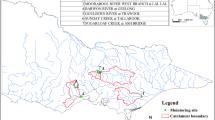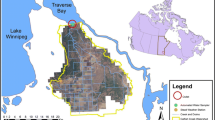Abstract
High-frequency, continuous monitoring using in situ sensors offers a comprehensive and improved insight into the temporal and spatial variability of any water body. In this paper, we describe a 7-month exploratory monitoring programme in Dublin Port, demonstrating the value of high-frequency data in enhancing knowledge of processes, informing discrete sampling, and ultimately increasing the efficiency of port and environmental management. Kruskal–Wallis and Mann–Whitney tests were used to show that shipping operating in Dublin Port has a small–medium effect on turbidity readings collected by in situ sensors. Turbidity events are largely related to vessel activity in Dublin Port, caused by re-suspension of sediments by vessel propulsion systems. The magnitudes of such events are strongly related to water level and tidal state at vessel arrival times. Crucially, measurements of Escherichia coli and enterococci contamination from discrete samples taken at key periods related to detected turbidity events were up to nine times higher after vessel arrival than prior to disturbance. Daily in situ turbidity patterns revealed time-dependent water quality “hot spots” during a 24-h period. We demonstrate conclusively that if representative environmental assessment of water quality is to be performed at such sites, sampling times, informed by continous monitoring data, should take into account these daily variations. This work outlines the potential of sensor technologies and continuous monitoring, to act as a decision support tool in both environmental and port management.












Similar content being viewed by others
References
APHA-AWWA-WEF (1992). Standard methods for the examination of water and wastewater (18th ed.). Washington DC: American Public Health Association, America Water Works Association and Water Environment Federation.
Bedri, Z., Bruen, M., Dowley, A., & Masterson, B. (2011). A three-dimensional hydro-environmental model of Dublin Bay. Environmental Modeling and Assessment, 16, 369–384.
Bedri, Z., Bruen, M., Dowley, A., & Masterson, B. (2013). Environmental consequences of a power plant shut-down: a three-dimensional water quality model of Dublin Bay. Marine Pollution Bulletin, 71, 117–128.
Bryan, G., & Langston, W. (1992). Bioavailability, accumulation and effects of heavy metals in sediments with special reference to United Kingdom estuaries: a review. Environmental Pollution, 75, 89–131.
Byappanahalli, M., Fowler, M., Shively, D., & Whitman, R. (2003). Ubiquity and persistence of Escherichia coli in a midwestern coastal stream. Applied and Environmental Microbiology, 69, 4549–4555.
Choiseul, V., Wilson, J., & Nixon, E. (1998). The distribution of hydrocarbons on the east and south-west Irish coasts and in the Liffey Estuary. Biology and Environment, 98B2, 75–86.
DCC (2006). Dublin waste to energy project environmental impact statement. Dublin City Council, Chapter 12, p. 48. http://www.dublinwastetoenergy.ie/uploads/archive/files/july-2006/technical_summary/Chapter_12_Water.pdf. Accessed 8 May 2014.
DPW (2012). Dublin Port Website. http://www.dublinport.ie/about-dublin-port/factsand-figures/. Accessed 22 June 2012.
Elliott, M., & McLusky, D. S. (2002). The need for definitions in understanding estuaries. Estuarine, Coastal and Shelf Science, 55, 815–827.
ESF Marine Board (2002). Integrating marine science in Europe. European Science Foundation Marine Board Position Paper 5, p. 148. http://www.eurocean.org/np4/file/129/IMS_PP_final.pdf. Accessed 8 May 2014.
EU (2006). Directive 2006/7/EC of the European Parliament and of the Council of 15 February 2006 concerning the management of bathing water quality. Official Journal of the European Union, 64, 37–51.
Field, A. (2005). Discovering Statistics Using SPSS (2nd ed.). London: SAGE Publication.
Garrad, P., & Hey, R. (1987). Boat traffic, sediment resuspension and turbidity in a broadland river. Journal of Hydrology, 95, 289–297.
Glasgow, H. B., Burkholder, J. M., Reed, R. E., Lewitus, A. J., & Kleinman, J. E. (2004). Real-time remote monitoring of water quality: a review of current applications, and advancements in sensor, telemetry, and computing technologies. Journal of Experimental Marine Biology and Ecology, 300, 409–448.
Hart, J. K., & Martinez, K. (2006). Environmental Sensor Networks: a revolution in the earth system science? Earth-Science Reviews, 78, 177–191.
Hayes, E., & Landis, W. (2004). Regional ecological risk assessment of a near shore marine environment: Cherry Point, WA. Human and Ecological Risk Assessment, 10, 299–325.
Healey, J. F. (2011). Statistics: A tool for social research. Belmont: Wadsworth Publishing.
Henley, W., Patterson, M., Neves, R., & Lemly, A. D. (2000). Effects of sedimentation and turbidity on lotic food webs: a concise review for natural resource managers. Reviews in Fisheries Science, 8, 125–139.
Hong, H., Xu, L., Zhang, L., Chen, J., Wong, Y., & Wan, T. (1995). Special guest paper: environmental fate and chemistry of organic pollutants in the sediment of Xiamen and Victoria Harbours. Marine Pollution Bulletin, 31, 229–236.
Horsburgh, J. S., Spackman Jones, A., Stevens, D. K., Tarboton, D. G., & Mesner, N. O. (2010). A sensor network for high frequency estimation of water quality constituent fluxes using surrogates. Environmental Modelling & Software, 25, 1031–1044.
Jannasch, H. W., Coletti, L. J., Johnson, K. S., Fitzwater, S. E., Needoba, J. A., & Plant, J. N. (2008). The Land/Ocean Biogeochemical Observatory: a robust networked mooring system for continuously monitoring complex biogeochemical cycles in estuaries. Limnology and Oceanography: Methods, 6, 263–276.
Johnson, K. S., Needoba, J. A., Riser, S. C., & Showers, W. J. (2007). Chemical sensor networks for the aquatic environment. Chemical Reviews, 107, 623–640.
Knowlton, A. R., Korsmeyer, F., Kerwin, J., Wu, H., & Hynes, B. (1995). The hydrodynamic effects of large vessels on right whales. Final report to the National Marine Fisheries Service Northeast Fisheries Science Center, Woods Hole, MA. Contract no. 40EANFF400534. http://nefsc.noaa.gov/publications/reports/40EANFF400534.pdf. Accessed 8 May 2014.
Lawlor, A., Torres, J., O’Flynn, B., Wallace, J., & Regan, F. (2012). DEPLOY: a long term deployment of a water quality sensor monitoring system. Sensor Review, 2, 29–38.
Lesage, V., Barrette, C., Kingsley, M., & Sjare, B. (1999). The effect of vessel noise on the vocal behavior of belugas in the St. Lawrence River Estuary, Canada. Marine Mammal Science, 15, 65–84.
Lindholm, T., Svartström, M., Spoof, L., & Meriluoto, J. (2001). Effects of ship traffic on archipelago waters off the Långnäs harbour in Åland, SW Finland. Hydrobiologia, 444, 217–225. doi:10.1023/A:1017518131889.
Mastran, T. A., Dietrich, A. M., Gallagher, D. L., & Grizzard, T. J. (1994). Distribution of polyaromatic hydrocarbons in the water column and sediments of a drinking water reservoir with respect to boating activity. Water Research, 28, 2353–2366.
Newcombe, C. P., & MacDonald, D. D. (1991). Effects of suspended sediments on aquatic ecosystems. North American Journal of Fisheries Management, 11, 72–82.
Ohrel, R. L., & Register, K. M. (2006). Volunteer estuary monitoring: A methods manual. Washington, DC: Ocean Conservancy.
Pachepsky, Y., & Shelton, D. (2011). Escherichia coli and fecal coliforms in freshwater and estuarine sediments. Critical Reviews in Environmental Science and Technology, 41, 1067–1110.
Perelo, L. W. (2010). Review: in situ and bioremediation of organic pollutants in aquatic sediments. Journal of Hazardous Materials, 177, 81–9.
Pettibone, G. W., Irvine, K. N., & Monahan, K. M. (1996). Impact of a ship passage on bacteria levels and suspended sediment characteristics in the Buffalo River, New York. Water Research, 30, 2517–2521.
Preston, D., Protopapas, P., & Brodley, C. (2009). Event discovery in time seriesIn. Proceedings of the SIAM International Conference on Data Mining, 2009, 61–72.
Regan, F., Lawlor, A., Flynn, B. O., Torres, J., Martinez-Catala, R., O’Mathuna, C., et al. (2009). A demonstration of wireless sensing for long term monitoring of water quality. Zurich: IEEE.
Roslev, P., Bastholm, S., & Iversen, N. (2008). Relationship between fecal indicators in sediment and recreational waters in a Danish estuary. Water, Air, & Soil Pollution, 194, 13–21.
Roth, S., & Wilson, J. G. (1998). Functional analysis by trophic guilds of macrobenthic community structure in Dublin Bay, Ireland. Journal of Experimental Marine Biology and Ecology, 222, 195–217.
Schoellhamer, D. H. (1993). Resuspension of bottom sediments, sedimentation, and tributary storm discharge Bayboro Harbor and the Port of St. Petersburg, Florida. Reston: U.S. Geological Survey.
Schoellhamer, D. H. (1996). Anthropogenic sediment resuspension mechanisms in a shallow microtidal estuary. Estuarine, Coastal and Shelf Science, 43, 533–548.
Soomere, T. (2005). Fast ferry traffic as a qualitatively new forcing factor of environmental processes in non-tidal sea areas: a case study in Tallinn Bay, Baltic Sea. Environmental Fluid Mechanics, 5, 293–323. doi:10.1007/s10652-005-5226-1.
Steets, B., & Holden, P. (2003). A mechanistic model of runoff-associated fecal coliform fate and transport through a coastal lagoon. Water Research, 37, 589–608.
Verney, R., Deloffre, J., Brun-Cottan, J., & Lafite, R. (2007). The effect of wave-induced turbulence on intertidal mudflats: impact of boat traffic and wind. Continental Shelf Research, 27, 594–612.
Wagner, R. J. (2006). Guidelines and Standard Procedures for Continuous Water-Quality Monitors: Station Operation, Record Computation, and Data Reporting. Reston: US Department of the Interior, US Geological Survey.
Wilson, J. (2002). Productivity, fisheries and aquaculture in temperate estuaries. Estuarine, Coastal and Shelf Science, 55, 953–967.
Yousef, Y. A. (1974). Assessing effects on water quality by boating activity. Cincinnati: National Environmental Research Center.
Yousef, Y. A., McLellon, W. M., & Zebuth, H. H. (1980). Changes in phosphorus concentrations due to mixing by motorboats in shallow lakes. Water Research, 14, 841–852.
Acknowledgments
This work was performed as part of the EU Framework 7 project “ATWARM” (Marie Curie ITN, No. 238273) and as part of The Beaufort Marine Research Award which is carried out under the Sea Change Strategy and the Strategy for Science Technology and Innovation (2006–2013) with the support of the Marine Institute funded under the Marine Research Sub-Programme of the National Development Plan 2007–2013. The authors also wish to thank the staff at Poolbeg Marina for permission, assistance and access to the deployment location and marina facilities.
Author information
Authors and Affiliations
Corresponding author
Rights and permissions
About this article
Cite this article
Briciu-Burghina, C., Sullivan, T., Chapman, J. et al. Continuous high-frequency monitoring of estuarine water quality as a decision support tool: a Dublin Port case study. Environ Monit Assess 186, 5561–5580 (2014). https://doi.org/10.1007/s10661-014-3803-9
Received:
Accepted:
Published:
Issue Date:
DOI: https://doi.org/10.1007/s10661-014-3803-9




